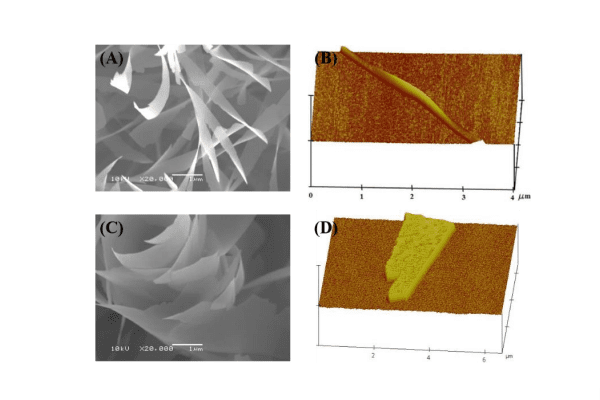Youfei Jiang

Youfei Jiang

Mechanical characterization of boron-based one-dimensional nanostructures by various techniques
Abstract:
One-dimensional (1D) nanostructures, such as nanotubes, nanowires and nanobelts, have attracted considerable interests in the last two decades because of their exceptional physical, chemical, and electrical properties. Engineering applications of these nanostructures such as in nanocomposites and nanoelectronics require accurate characterization and complete understanding of their mechanical properties. In this dissertation, the mechanical properties of boron-based 1D nanostructures, a promising class of high temperature thermoelectric nanomaterials, are investigated. The work includes three parts: (1) nanoindentation of &agr;-tetragonal boron nanoribbons and nanoplatelets, (2) implementation of a nanomanipulator system for in situ mechanical testing of 1D nanostructures within a scanning electron microscope, and (3) study of mechanical properties of boron carbide (B4C-type) nanowires both experimentally and numerically. All experimental mechanical tests were on individual nanostructures. This dissertation work resulted in a nanomanipulator with better performance, as well as provided more reliable data related to the fundamental properties which currently are quite scarce for boron-based 1D nanostructures.
Nanoindentation was employed to characterize mechanical properties of &agr;-tetragonal boron nanostructures such as nanoribbons and nanoplatelets. Optimal experimental conditions for indentations at shallow depths were systematically investigated. Following this mechanical characterization on &agr;-tetragonal boron platelets using nanoindentation was performed. The results demonstrate that the substrate used to support the nanostructure plays a critical role in determination of the measured properties. To rule out the substrate effect, a new simple approach was proposed to extract the intrinsic properties of boron nanoplatelets. The derived Young’s modulus of &agr;-tetragonal boron nanostructures is 69 ± 4 GPa, which is comparable to that reported for &agr;-rhombohedral boron nanobelts.
To realize in situ mechanical characterization of 1D nanostructures within a scanning electron microscope, a nanomanipulator system was designed and implemented. The system is desired to test 1D nanostructures whose cross sections are circular and their mechanical properties are not suitable to be studied by nanoindentation. The system consists of three linear motion and two rotation stages. It has positioning resolutions in XYZ directions at 20-30 nm, and has around 0.04° resolution in rotation. The system is capable of performing resonance vibration, tensile and buckling tests on individual 1D nanostructures. Compared to other home-built nanomanipulator systems reported, the current one has the following improvements. Frist, each individual nanowire can now be tested by two different techniques so that direct comparison of experimental data can be made. Second, the force measurement resolution is improved as compared to others’ work. Third, the accuracy of determination of the length of a tested nanowire is increased with the help of the additional rotational stage. These improvements facilitate more accurate mechanical characterization of 1D nanostructures.
Mechanical properties of boron carbide nanowires were studied both experimentally and numerically. The experimental work, with a focus on resonance vibrational testing, was conducted on individual boron carbide nanowires using the home-built nanomanipulator system. Mechanical properties such as Young’s modulus and fracture strength, were obtained. The numerical finite element modeling (FEM) work was done by the commercial software ABAQUS. Various factors ( e.g., the non-uniformity of a nanowire, the amorphous carbon coating resulted from the electron beam induced deposition (EBID) process, etc.) which could affect the accuracy of measured properties were studied. There are two significant contributions of this part of the dissertation work. (1) For each measured nanowire, its mechanical properties were correlated to its microstructure (e.g., diameter, orientation of planar defects, the preferred growth direction of a nanowire, etc.), so that more accurate values of mechanical properties of boron carbide nanowires have been obtained. (2) The effect of amorphous carbon coating formed during EBID was systematically studied for the first time. Results showed that the orientation of planar defects played an important role in determining the Young’s modulus of boron carbide nanowires. The Young’s modulus of a nanowire whose planar defects are perpendicular to its preferred growth direction (i.e., a transverse-faulted TF nanowire) could be up to 67% higher than that of a nanowire whose planar defects are parallel to its preferred growth direction (i.e., an axial-faulted AF nanowire). Although the TF nanowires are as stiff as bulk boron carbide (Ebulk = 432-480 GPa), they exhibit excellent flexibility which is unusual for brittle ceramic material. Results also indicated that the amorphous carbon coating had profound effects to the measured results. For example, depending on the aspect ratio of a nanowire, the addition of amorphous carbon coating could result in up to 153% overestimation of the Young’s modulus. This study provided a guideline for further study on amorphous coatings on nanowires, and also offered an alternative explanation of large variations in results from in situ scanning electron microscopy-based tests widely observed in the field.
Sponsoring Chair: Dr. Terry T. Xu
Committee: Dr. Jordan Poler, Dr. Howie Fang, Dr. Stuart Smith, Dr. Aixi Zhou